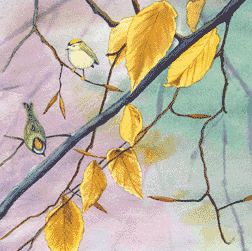|
Loading
|
|||
|
|||
|
|
February: Pointing toward SpringThat time of year thou mayst in me behold When yellow leaves, or none, or few, do hang Upon those boughs which shake against the cold, Bare ruin’d choirs, where late the sweet birds sang. —William Shakespeare In February, if it is cold, the sweet birds will be mostly silent or gone. The ones that remain here in winter don’t say much, especially when the weather is cold. The kinglets, creepers, chickadees and wrens stay fairly silent this time of year. This time of the year, the pale yellow leaves of the beech tree are like paper lanterns that catch the light. They add a warm note of color to the muted background of olive and ochre. They make a slight rustling sound when they shake in a light breeze. The smooth pale trunks also stand out, sometimes blue-gray, sometimes creamy yellow with a tinge of algae green. Their buds hold themselves in reserve, for now. The warm spell of false spring in January might have stimulated a spurt of growth, but unlike some early bloomers, the beeches did not get ahead of their time. The miniature leaves are safely wrapped in their paper-thin casing. Young beeches hold their leaves all winter, as do young oaks. The species belong to the same botanic family and so share this characteristic. It must have been English beech trees that Shakespeare was thinking of; they are the ones that turn yellow. In fall they start out a brown-orange and fade to yellow, turning nearly white by April. When the weather warms and the daytime temperatures reach the 50s, the rare hepatica will bloom and the bloodroot will follow. Then it won’t be too long before true spring arrives and beech buds begin to stretch out, becoming quite long before the bright green leaves unfurl. |
||
|
|
|||
|
© COPYRIGHT 2004 by New Bay Enterprises, Inc. All rights reserved. |




